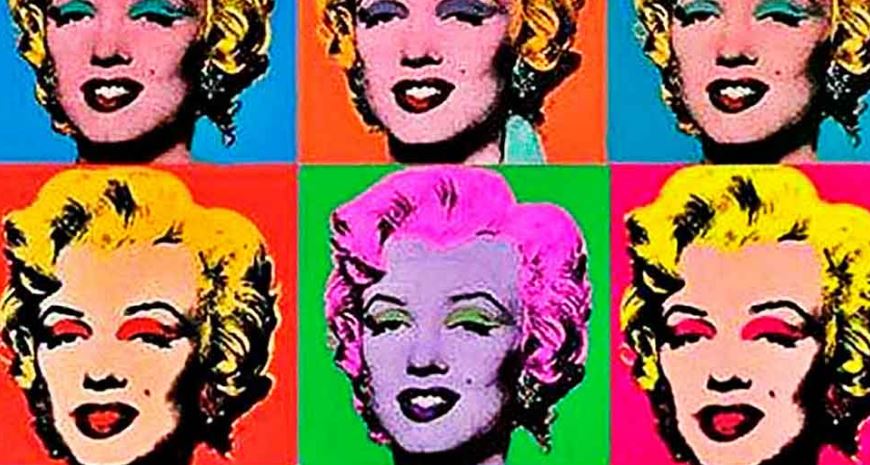When you hear Pop art, images of Andy Warhol's Campbell's Soup Cans and Roy Lichtenstein' stylized comic strip paintings probably come to mind. The Pop art movement began in the 1950s but its transient, expendable and glamorous style continues to inspire artists to this day and its sexy, young, big business edge still magnetizes art collectors around the world. Let's delve into this art movement and find a true definition for Pop art.
What is Pop art? Definition and main characteristics
The birth of an original art form
The Pop art movement began in the mid-1950s in England and caught on across the Atlantic in the United States a few years later. This artistic movement was created as a reaction to Abstract Expressionism, which was seen by some artists of the time as being too rigid and pretentious. The 1950s Independent Group (IG) is regarded as the precursor to the British Pop Art movement. This group was headed by Eduardo Paolozzi, the king of collages, his work was some of the first to incorporate advertisements, comic book characters and magazine covers.
Andy Warhol: Embodying artistic renewal
Andy Warhol (1928-1987) represents one, if not THE most important figure in Pop art. Born in Pittsburgh, Pennsylvania, USA, he first worked as a commercial illustrator before delving into the art world. He became skilled as a painter, screen-printer, director, music producer and author. His paintings of American icons (Troy Donahue, Marilyn Monroe, Elvis Presley, Nathalie Wood, Warren Beatty, etc.) and consumer products (the Campbell's Soup Can) have become famous around the world.
What is Pop art?
An abbreviation of Popular Art, Pop art is characterized by a deconstruction of images seen in popular culture – television, comic books, magazines, movies and other various forms of advertising. These elements were represented objectively and borrowed the commercial techniques used by the media from which the subjects were borrowed.
Defining Pop art through a sociological lens
What is Pop art from a sociological stand point? Pop Artists embraced the fact that their images could be mass produced, easily accessible, expendable and transient. This idea was promoted by the writer Walter Benjamin in his book The Work of Art in the Age of Mechanical Reproduction (1935). Benjamin stated that a copy was of higher social significance than an original because it could be possessed and enjoyed by the buyer at any moment. This idea had a profound effect on postmodern thought and highly influenced the Pop art movement.
Social critique
Pop art is a critique of the materialism and consumerism present in modern societies. The idea behind the piece of art became more important than the work itself.
In Brazil, Pop art has become an instrument for denouncing the political regime's social abuse and totalitarian aspects of their policies during the military dictatorship in the 1960s. Romero Britto and Gabriel Grecco are prime examples of Brazilian Pop artists. However Grecco's technique teeters between Street and Pop art with a fresh voice that resembles that of Banksy.
Key figures and masterpieces
The Pop art movement has produced many other major artists in addition to Andy Warhol, whose Marylin Diptych is known throughout the world. Often times the best way of defining a major art movement like Pop art is best done by looking at examples of key pieces and figures that contributed to them.
Roy Lichtenstein
Born in New York in 1923, Roy Lichtenstein is a master of drawing, which he studied at the Art Students League of New York. He is known for creating enormous, stylized reproductions of comic strips using dots to mimic the flat tones of used in commercial printing. This innovative artist is a key figure of Pop art alongside Andy Warhol. Crying Girl (1963) is one of his best known works.
Sir Peter Thomas Blake
The Englishman Sir Peter Thomas Blake, born in 1932, attended the greatest art institutes in England. He created collages combining images from pop culture and fine art. He is best known for co-creating the album cover for the Beatles' album Sgt. Pepper's Lonely Hearts Club Band.
Jasper Johns
Jasper Johns is an internationally renowned Neo-Dada painter and printmaker. His work concentrated on depicting ordinary objects like flags and maps and helped create the shift from Abstract Expressionism to Pop art. His most famous piece is the encaustic painting Flag (1954-1955). He created this piece after having a dream in which he was painting the American flag.
Wayne Thiebaud
Wayne Thiebaud is an American painter and printmaker who is often compared to Edward Hopper. He is best known for painting still lifes of everyday objects such as food and cosmetics. Some art historians classify him as a Pop artist due to the banality of his subject matter however the fact that he painted from real life instead of media images makes him technically unclassifiable as Pop artist. One of his most famous pieces is the Dark Cake created in 1983.
If you enjoyed learning about Pop art, feel free to browse Artalistic's website. We are one of the world's leading online platforms for purchasing and selling Contemporary art. We have an extensive and carefully curated collection of paintings, sculptures, photographs and drawings by established and emerging artists.
 English
English Français
Français


You must be logged in to post a comment.
Click here to log in